Evolution of Nonclassical MHC Genes and Innate T Cells
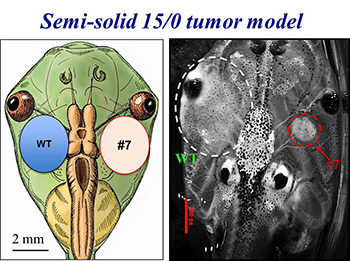
Growing (WT) and rejected class Ib-deficient (#7#) semi-solid
tumor graft 7 days post-transplantation (5x105 tumor cells)
1) Role of class Ib-restricted invariant T cells during viral and bacterial infections: We have identified in Xenopusadults and tadpoles a class Ib-restricted semi-invariant T cell (iT) population with many similarities to the mammalian iNKT. While recent data have shown that in mammals these cells appear to play critical roles in host defense against important pathogens including viruses and mycobacteria the full biological significance of these iT cells is still unknown. We have shown that in Xenopus these iT cells are critical for antiviral immunity, especially in tadpoles when classical MHC class I function is suboptimal.
To further characterize the functional role of these iT cells during the immune response we are studying the involvement of these cells during viral and bacterial challenge using the poxvirus-like ranavirus FV3 and the bacteria Mycobacterium marinum. In collaboration with Dr. Erin Adams (University of Chicago), we are characterizing putative Xenopus class Ib ligands or antigens as well as the interaction between invariant TCR and class Ib molecules.
We are exploring this possibility by using a reverse genetic loss of function approach that combines transgenesis and RNA interference. Specifically, we are in process of silencing 5 different class Ib genes that are preferentially expressed by thymocytes and determine the impact on the representation of the 5 dominant TCR rearrangements. We are also currently implementing the use of the CRISPR/Cas9 system.
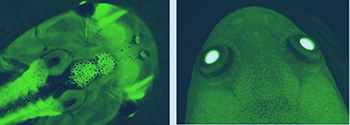
Transgenic cloned X. laevis tadpole and young adult
2) Role of class Ib genes in differentiation and function of innate T cells: We have shown using deep-sequencing approach that, unlike adults, Xenopus tadpoles have a limited TCR repertoire with several dominant invariant rearrangements. This suggests that multiple distinct populations of iT cells are predominant during early development. Since there is no consistent classical MHC class Ia expression at this early developmental stage, we postulate that class Ib molecules are involved in the differentiation and function of these invariant T cells.
To better reveal the respective role of class Ia and class Ib genes in immune surveillance, we are developing reverse genetic strategies to modulate their expression in vivo by RNAi knockdown, CRISPR/Cas9-mediated genome editing and induced transgene expression both in tumor by transfection and in animals by transgenesis.
3) Role of non-polymorphic MHC and innate T cells in distinct immune responses against mycobacteria between resistant adult frog and tolerant tadpoles:
The biological relevance of innate (i)T cells, which represent a substantial portion of human T cells, is just starting to emerge and will benefit from molecular evolutionary comparisons in a vertebrate species genetically distant from mammals. We have leveraged Xenopus to study iT cell responses to non-TB mycobacteria such as M. marinum and M. abscessus at two distinct life stages, tadpole and adult frogs. Adult frogs possess efficient conventional T cell–mediated immunity, whereas tadpoles predominantly rely on innate (i)T cells. We have shown that show that, although anti–M. marinum immune responses between tadpoles and adults are different, tadpoles are as resistant to M. marinum inoculation as adult frogs. However, M. marinum inoculation triggers a robust proinflammatory CD8+ T cell response in adults, whereas tadpoles elicit only a noninflammatory CD8 negative- and iT cell–mediated response (http://www.jimmunol.org/content/early/2019/10/04/jimmun).
The non-polymorphic MHC-like XNC4, is required for the development of the iT cell subset defined by the invariant TCRα Vα45-Jα1.14 (iVα45-T). Loss-of-function by transgenesis has revealed that both XNC4 deficiency that ablates iVα45T cell development and the direct disruption of the iVα45-Jα1.14 T cell receptor dramatically impairs tadpole resistance to Mycobacteria infections (https://doi.org/10.1073/pnas.1722129115). Recent preliminary data obtained in collaboration with Erin Adams’s group (U. Chicago) suggest that XNC4 presents unusually long peptides (9-12 mer).
We are now interested to investigate the role of XNC4 presentation and iT cells effector function in tadpoles versus adult frogs using XNC4 tetramers, XNC4 specific nanobodies, recombinant fluorescent mycobacteria and CRISPR/Cas9 reverse genetics in transgenic Xenopus strains combined with flow cytometry, ImageStream, confocal microscopy and transcriptomics.
This research has the potential to identify novel conserved mycobacteria PAMPS and to elucidate mechanisms by which immune cells activate innate T cells in a genetically distant non-mammalian species, and thus provide fundamental and widely relevant insights into host defenses against non-TB mycobacteria and even Mtb. Characterizing conserved ligands and defense mechanisms against mycobacteria will contribute to developing novel suitable therapeutic strategies.
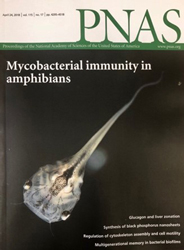
First page of our publication on the role of XNC4 in immunity against mycobacteria (https://doi.org/10.1073/pnas.1722129115)
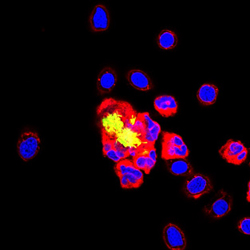
Xenopus tadpole macrophage (red) infected with fluorescent (yellow) M. marinum.
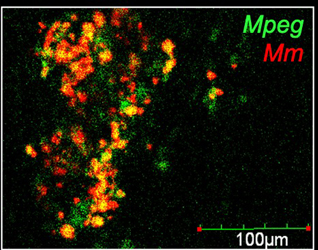
Macrophages expressing gfp under the mpeg reporter in transgenic a tadpole infected with fluorescent M. marinum (red).
4) Role of class Ib genes and invariant T cells in tumor immunity: The comparative tumor-immunity model developed in Xenopus provides an attractive alternative to mice for exploring the role of class Ib molecules to generate responses against tumors that have down-regulated their MHC class Ia molecules thereby escaping immune surveillance.
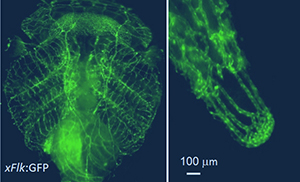
Flk-gfp transgenic tadpole and anterior adult toe with
fluorescent blood vessel endothelium
We have also developed a semi-solid tumor transplantation assay using collagen embedded tumor allowing us to visualize the tumor/ immune cell interaction as well as neovascularization in vivo. In collaboration with Edward Brown and Minsoo Kim, we are in the process to adapt this semi-solid tumor model in transparent Xenopus tadpole for intravital microscopy (two photon and confocal).